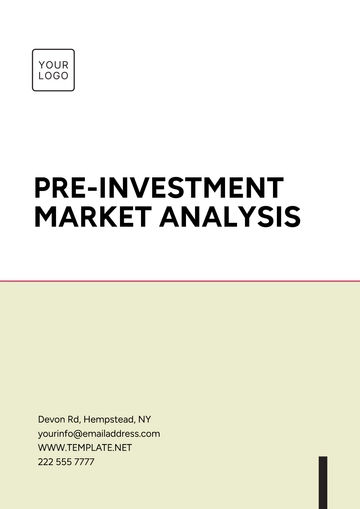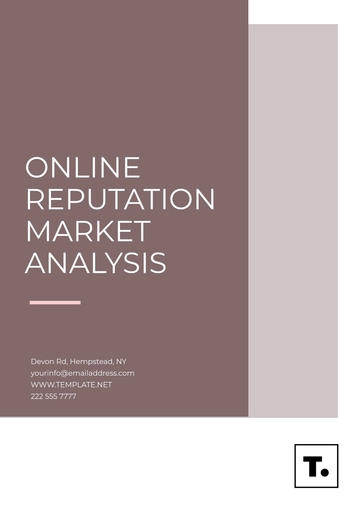Free Advertising Media Buying Post-Campaign Analysis

I. Introduction
This Post-Campaign Analysis Report is prepared to evaluate the media buying performance of the recent campaign conducted by [Your Company Name]. The aim is to assess the effectiveness of our media buying strategies, budget allocation, and overall campaign execution. This analysis will help in identifying areas of success and opportunities for improvement in future campaigns.
II. Campaign Overview
This section presents an in-depth overview of the [Campaign Name] campaign conducted by [Your Company Name]. This overview is designed to provide a clear understanding of the campaign's scope and approach, setting the stage for a detailed evaluation of its performance. The insights gathered here are crucial for assessing the effectiveness of the media buying strategies and overall campaign impact.
Campaign Name: [Campaign Name]
Campaign Duration: (3 months)
Primary Objective: To introduce and build brand awareness for the next campaign.
Total Budget: $[000.000]
III. Strategic Approach:
Target Audience:
Demographics: The campaign targeted young adults aged 18-35, primarily urban dwellers, who are college-educated and employed in tech-centric industries. This group is known for its disposable income and willingness to invest in the latest technology.
Psychographics: This audience comprises early adopters and tech enthusiasts who not only value advanced features and sleek design in smart devices but also seek products that enhance their productivity and lifestyle. They are driven by innovation and often serve as opinion leaders in their social circles.
Behavioral Traits: These individuals are digital natives, highly active across multiple social media platforms, and engage regularly with tech-related content. Their online behavior indicates a responsiveness to targeted, interactive marketing campaigns and a penchant for sharing their tech experiences online.
Media Mix Strategy:
Digital: This segment focused on programmatic ads, search engine marketing (SEM), and custom content on leading tech websites and forums. It aimed at capturing the audience through engaging, interactive ad formats like augmented reality (AR) experiences and video demos.
Social Media: Investment in platforms like Instagram, Twitter, YouTube, and TikTok, targeting users through influencer partnerships, branded content, and targeted advertising. The strategy included interactive features like polls, live Q&A sessions with product experts, and user-generated content competitions.
Television: Placement of adverts during prime-time slots on popular tech and lifestyle channels, along with sponsorship of tech-related shows and segments, to reach a broader audience segment that values visual and engaging content.
Print: Collaborations with leading tech magazines for feature articles, product reviews, and innovative ad formats like fold-outs and QR codes that link to interactive digital content.
Outdoor: Strategic placement of high-tech, interactive billboards in urban tech hubs and transit areas, leveraging digital screens for dynamic, eye-catching displays that engage passersby with real-time features of the smartwatch.
Budget Allocation:
Medium | Percentage |
|---|---|
Digital | 40% |
Social Media | |
Television | |
Outdoor |
Creative Concept:
The campaign's creative theme, "[Theme]," was brought to life through a fusion of futuristic aesthetics and relatable, real-world scenarios. It showcased the company’s new Smartwatch as not just a gadget but as a lifestyle companion, highlighting features like health tracking, connectivity, and customizability. The campaign's visual narrative used state-of-the-art graphics and immersive storytelling to convey the watch’s role in enhancing daily life, both professionally and personally.
Key Partnerships and Sponsorships:
Influencer Collaborations: Teamed up with a diverse range of tech influencers, from well-known YouTubers to rising Instagram tech personalities, ensuring a wide and impactful reach.
Tech Events and Webinars: Sponsored and participated in major tech expos, webinars, and virtual product launches, providing opportunities for live demonstrations and direct engagement with tech enthusiasts and potential customers.
Community Engagement Initiatives: Launched online forums and community groups focused on tech innovation, encouraging discussions and feedback around the Smartwatch, fostering a sense of community and brand loyalty.
IV. Media Buying Strategy
In this section, we delve into the strategies employed for the campaign, this strategy is a blend of cutting-edge technology and creative marketing techniques, designed to maximize campaign reach and impact. Understanding these elements provides insight into how the campaign effectively reached and engaged its target audience.
Programmatic and Real-Time Bidding (RTB): A significant portion of the digital media budget was allocated to programmatic buying, utilizing RTB for efficient ad placements. This approach ensured ads were displayed to the target audience at optimal times, leveraging machine learning and AI for enhanced targeting and bid optimization.
Cross-Channel Synergy: The strategy involved synchronized messaging across different channels to create a cohesive brand story. This included aligning social media content with TV adverts and print media, ensuring that the campaign message was consistent and amplified across all platforms.
Geo-Targeting and Retargeting: Leveraged geo-targeting in digital and outdoor advertising to reach audiences in tech hubs and metropolitan areas. Retargeting strategies were employed to re-engage users who interacted with the ads but did not convert, using tailored messaging to guide them through the conversion funnel.
Contextual and Behavioral Targeting: Applied advanced targeting techniques in digital advertising to reach audiences based on their online behavior and the context of the websites they visited. This strategy ensured higher relevance and engagement of the ads.
Ad Format Innovation: Embraced innovative ad formats like interactive video ads, AR experiences, and shoppable ads on social media to engage the audience and provide an immersive brand experience.
V. Performance Metrics
This part of the report focuses on the comprehensive performance metrics used to evaluate the effectiveness of the campaign. We will discuss a range of key indicators, from reach and frequency to conversion rates and ROAS (Return on Ad Spend). This section aims to provide an overview of the campaign's performance, assessing the quantitative and qualitative measures. These metrics are crucial for understanding the campaign’s success and for guiding future strategic decisions:
Reach and Frequency: Measured the total number of unique users exposed to the campaign and the average number of times those users saw the campaign. This metric helped understand the campaign's breadth and depth of audience engagement.
Click-Through Rate (CTR): Monitored the percentage of users who clicked on the ads after seeing them. A higher CTR indicated effective ad design and targeting.
Conversion Rate: Key performance indicator measuring the percentage of users who took the desired action (such as making a purchase or signing up for a webinar) after clicking on the ad.
Return on Ad Spend (ROAS): This crucial financial metric calculates the revenue generated for every dollar spent on advertising, providing a direct measure of the campaign's financial effectiveness.
Engagement Metrics: Tracked user interactions with the ads, including likes, shares, comments, and video views. This provided insights into how compelling and engaging the campaign content was.
Viewability and Ad Recall: Assessed the percentage of ads that were actually seen by users and the extent to which the target audience remembered the ads. High viewability and recall rates were indicative of effective ad placement and creative resonance.
Brand Lift: Measured the impact of the campaign on brand perception, including awareness, consideration, and preference. Surveys and brand sentiment analysis tools were utilized to gauge this metric.
Cost Per Acquisition (CPA): Calculated the average cost incurred for each conversion, helping in evaluating the cost-effectiveness of the campaign and guiding future budget allocations.
VI. Campaign Performance Data
[Campaign Name]’s performance data is a crucial component of our post-campaign analysis. This section provides an in-depth look at the data gathered across various media channels, offering a comprehensive view of how each element of the media mix contributed to the overall success of the campaign.
Media Channel Performance:
Media Channel | Budget Allocated | Impressions | ROI | Clicks | Conversions | Cost Per Click |
|---|---|---|---|---|---|---|
Social Media | $60,000 | 1,500,000 | 125% | 75,000 | 1,500 | $0.80 |
Digital | ||||||
Television | ||||||
Radio | ||||||
Outdoor | ||||||
Total: |
Analysis of Performance Data:
Channel Effectiveness: Evaluate each channel's effectiveness in reaching the campaign objectives. For instance, social media and digital display showed strong performance in terms of CTR and conversions.
Cost Efficiency: Analyze the cost-effectiveness of each channel, looking at metrics like cost per click (CPC) and cost per conversion. This analysis helps in understanding which channels provided the most value for the investment.
Audience Engagement: Assess audience engagement levels across different channels. High impressions in television and radio indicate broad reach, while digital channels showed higher engagement and interaction.
ROI Analysis: The ROI for each channel and the overall campaign ROI provide insights into the financial effectiveness of the media buying strategy.
VII. Analysis and Insights
The analysis and insights derived from the campaign offer valuable learnings for [Your Company Name]. This section delves into a deeper understanding of how each aspect of the media buying strategy contributed to the campaign's overall success and areas where improvements can be made.
Key Takeaways:
Optimal Channel Utilization: The high engagement rates on digital and social media channels suggest that these platforms were effectively utilized, resonating well with the target demographic. However, traditional channels like radio and print underperformed, indicating a need to reevaluate their role in future campaigns.
ROI and Cost Efficiency: The digital display channel yielded the highest ROI, demonstrating its effectiveness in reaching and engaging the target audience cost-effectively. In contrast, the lower ROI in print and radio suggests a need for renegotiation of rates or a shift in budget allocation to more efficient channels.
Audience Engagement and Behavior: High engagement on interactive ad formats points to the effectiveness of innovative and immersive advertising. Future campaigns could benefit from further leveraging these formats, especially in digital and social media.
Conversion Optimization: While the campaign achieved a good conversion rate, there's room for improvement. A/B testing of ad creatives and landing pages could help optimize conversions in future campaigns.
Cross-Channel Synergy: The campaign demonstrated the importance of a cohesive message across all channels. Further integration and consistency in messaging can amplify campaign effectiveness.
Strategic Recommendations:
Refocus Media Allocation: Shift more budget towards high-performing digital channels while reevaluating the role of traditional media in reaching our target audience.
Enhance Targeting Strategies: Implement more advanced targeting techniques, including AI-driven personalization, to increase ad relevance and engagement. Also to explore new advertising technologies such as AR and VR to create more immersive ad experiences, particularly in digital campaigns.
VIII. Conclusion
This Post-Campaign Analysis for the [Campaign Name] provides a holistic view of [Your Company Name]'s media buying performance. The insights and recommendations outlined in this report are instrumental in refining our media buying approach. By continuously evolving our strategies based on these learnings, [Your Company Name] is well-positioned to remain at the forefront of innovative and successful media buying in an ever-changing advertising landscape.
- 100% Customizable, free editor
- Access 1 Million+ Templates, photo’s & graphics
- Download or share as a template
- Click and replace photos, graphics, text, backgrounds
- Resize, crop, AI write & more
- Access advanced editor
By using our Advertising Media Buying Post-Campaign Analysis Template, you’ll have a layout tool that is designed to evaluate the effectiveness of your media buying strategies after a campaign concludes! It offers a structured format for analyzing outcomes and deriving actionable insights for future campaigns. It's also editable and customizable with our AI editor tool for your convenience. Get it now at Template.net!





























